
Flexco Floors | 1401 E. 6th St. - Tuscumbia, AL 35674
P: 866.955.8291 | F: 419.436.4302 | flexcofloors.com | Made in the USA
08.14.2017 | Page 1
TECHNICAL DATA SHEET
RUBBER STAIR TREADS,
RISERS & STRINGERS
Distinct Designs
Flexco Distinct Designs rubber stair
treads, risers and stringers are specifically
designed for use on all interior stairs,
including pan-filled concrete and wood
substrates. Distinct Design treads are
vulcanized and compression-molded
from a high-grade synthetic rubber
compound that is solid, homogeneous
and durable.
Flexco offers a variety of options within
the Distinct Designs product line,
including treads with abrasive, smooth or
ribbed inserts in a multitude of standard
colors and the option to customize colors
and color combinations. Distinct Designs
stair treads, risers and stringers can be
paired with Distinct Designs rubber
tiles on landings to create a consistent
appearance from surface to surface.
Distinct Designs stair treads are ideal
for indoor use in most commercial
or industrial applications, such
as schools, hospitals, department
stores, government buildings, hotels,
dormitories, sports complexes, airport
terminals, shopping malls and any other
public or private building.
• PVC Free
• Does Not Require A Finish
• Extremely Durable
• ADA Compliant
• Optimized For Visually Impaired
• Excellent Chemical Resistance
• Excellent Slip Resistance
• Recyclable
• Qualifies for LEED
®
Credits
• FloorScore
®
Certification
LEED v2009 IEQ Credit 4.1:
LEED v2009 IEQ Credit 4.3:
ASTM F2169 – Resilient Stair Treads:
ASTM E648 (NFPA 253) - Critical Radiant Flux:
ASTM E662 (NFPA 258) - Smoke Density:
CAN/ULC-S102.2 - Surface Burning:
ASTM F925 – Chemical Resistance:
ASTM D2047 – Slip Resistance:
ASTM F1514 – Heat Stability:
Acclimation Time:
Storage & Acclimation Temperature:
Qualifies
Qualifies
Type TS, Class 1 & 2,
Group 1 & 2, Grade 1
Class I, > 0.45 W/cm2
Passes, <450
FSR 115, SDS 275
Passes (see chart)
> 0.6
Passes
48 Hours
65° - 85° F
Product Description
Technical Data Features
Approved Excelsior Adhesives
AW-510 Acrylic Wet-Set Adhesive
EN-610 Epoxy Nose Filler Adhesive
C-630 Contact Adhesive
TP-620 Pressure-Sensitive Tape
MS-700 Modified Silane Wet-Set Adhesive
EW-710 Epoxy Wet-Set Adhesive
Availability, Cost & Samples
Flexco products are sold through
distribution. To locate the nearest
distributor, visit flexcofloors.com or
send an e-mail to info@flexcofloors.
com.
Technical Documents & Support
Additional product resources and
technical documents are available
online at flexcofloors.com. For
additional technical support, send an
e-mail to solutions@rhctechnical.
com.
Additional Information

08.14.2017 | Page 2
Flexco Floors | 1401 E. 6th St. - Tuscumbia, AL 35674
P: 866.955.8291 | F: 419.436.4302 | excooors.com | Made in the USA
TECHNICAL DATA SHEET
RUBBER STAIR TREADS, RISERS & STRINGERS
Distinct Designs
Smooth Treads
Nose Type:
Nose Length:
Leading Edge Thickness:
Back Edge Thickness:
Tread Depth:
Tread Length:
Safety Strip:
Coordinating Landing Tile:
Weight Per Lineal Foot:
Treads Per Carton:
Standard Square
1 5/8" (41.27 mm)
3/16" (4.76 mm)
1/8" (3.2 mm)
12 1/4" (311.15 mm)
Available in Lengths From
36" to 72" in 6" Increments
None
Smooth (SM) Profile Sheet or Tile
1.5 lbs.
10
120 Heavy Duty Smooth Tread
Nose Type:
Nose Length:
Leading Edge Thickness:
Back Edge Thickness:
Tread Depth:
Tread Length:
Safety Strip Width - 170:
Safety Strip Width - 130:
Safety Strip Spacing:
Safety Strip Material:
Coordinating Landing Tile:
Weight Per Lineal Foot:
Treads Per Carton:
Standard Square
1 5/8" (41.27 mm)
3/16" (4.76 mm)
1/8" (3.2 mm)
12 1/4" (311.15 mm)
Available in Lengths From
36" to 72" in 6" Increments
One 2" (50.8 mm) insert
Two 3/4" (19 mm) inserts
~3/4" (19 mm) From Nose,
1 1/4" (31.75 mm) Between
Carborundum
Smooth (SM) Profile Sheet or Tile
1.5 lbs.
10
130 & 170 Heavy Duty Smooth Safety Treads
Radial Treads
500 & 575 Extra Heavy Duty Radial Treads
Nose Type:
Nose Length:
Leading Edge Thickness:
Back Edge Thickness:
Tread Depth:
Tread Length:
Safety Strip Width - 500:
Safety Strip Width - 575:
Safety Strip Spacing:
Safety Strip Material:
Coordinating Landing Tile:
Weight Per Lineal Foot:
Treads Per Carton:
Metal-Reinforced Square
2" (39.69 mm)
5/16" (7.94 mm)
1/8" (3.2 mm)
12" (304.8 mm)
Available in Lengths From
36" to 72" in 6" Increments
None
One 2" (50.8 mm) insert
~3/4" (19 mm) From Nose
Carborundum, Ribbed or Smooth
Radial (RBT) High Profile Tile
2.8 lbs.
6
550 & 585 Heavy Duty Radial Treads
Nose Type:
Nose Length:
Leading Edge Thickness:
Back Edge Thickness:
Tread Depth:
Tread Length:
Safety Strip Width - 550:
Safety Strip Width - 585:
Safety Strip Spacing:
Safety Strip Material:
Coordinating Landing Tile:
Weight Per Lineal Foot:
Treads Per Carton:
Adjustable Square
2" (39.69 mm)
3/16" (4.76 mm)
1/8" (3.2 mm)
12" (304.8 mm)
Available in Lengths From
36" to 108" in 6" Increments
None
One 2" (50.8 mm) insert
~3/4" (19 mm) From Nose
Carborundum, Ribbed or Smooth
Radial (RBT) High Profile Tile
2.4 lbs.
6 (4 for all treads over 72")
Nose Type:
Nose Length:
Leading Edge Thickness:
Back Edge Thickness:
Tread Depth:
Tread Length:
afety Strip Width - 701:
Safety Strip Width - 776:
Safety Strip Spacing:
Safety Strip Material:
Coordinating Landing Tile:
Weight Per Lineal Foot:
Treads Per Carton:
Adjustable Square
1 9/16" (39.69 mm)
3/16" (4.76 mm)
1/8" (3.2 mm)
12" (304.8 mm)
Available in Lengths From
36" to 108" in 6" Increments
None
One 2" (50.8 mm) insert
~3/4" (19 mm) From Nose
Carborundum, Ribbed or Smooth
Radial II (RGT) Tile
2 lbs.
6 (4 for all treads over 72")
701 & 776 Heavy Duty Radial II Treads
Nose Type:
Nose Length:
Leading Edge Thickness:
Back Edge Thickness:
Tread Depth:
Tread Length:
Safety Strip Width - 701E:
Safety Strip Width - 776E:
Safety Strip Spacing:
Safety Strip Material:
Coordinating Landing Tile:
Weight Per Lineal Foot:
Treads Per Carton:
Adjustable Square
1 9/16" (39.69 mm)
1/4" (6.35 mm)
5/64" (1.98 mm)
15" (381 mm)
Available in Lengths From
36" to 72" in 6" Increments
None
One 2" (50.8 mm) insert
~3/4" (19 mm) From Nose
Carborundum, Ribbed or Smooth
Radial II (RGT) Tile
2 lbs.
6 (4 for all treads over 72")
701E & 776E Heavy Duty Extended Radial II Treads

08.14.2017 | Page 3
Flexco Floors | 1401 E. 6th St. - Tuscumbia, AL 35674
P: 866.955.8291 | F: 419.436.4302 | excooors.com | Made in the USA
TECHNICAL DATA SHEET
RUBBER STAIR TREADS, RISERS & STRINGERS
Distinct Designs
Profiled Treads
Nose Type:
Nose Length:
Leading Edge Thickness:
Back Edge Thickness:
Tread Depth:
Tread Length:
Safety Strip Width - 800:
Safety Strip Width - 875:
Safety Strip Spacing:
Safety Strip Material:
Coordinating Landing Tile:
Weight Per Lineal Foot:
Treads Per Carton:
Metal-Reinforced Square
1 1/4" (31.75 mm)
1/4" (6.35 mm)
1/8" (3.2 mm)
12 1/4" (311.15 mm)
Available in Lengths From
36" to 72" in 6" Increments
None
One 2" (50.8 mm) insert
~3/4" (19 mm) From Nose
Carborundum, Ribbed or Smooth
Square
2
(SQ) Tile
2.8 lbs.
6
900 & 975 Heavy Duty Hammered Treads
Diamond Treads
650 SN & 685 SN Heavy Duty Diamond Treads
Nose Type:
Nose Length:
Leading Edge Thickness:
Back Edge Thickness:
Tread Depth:
Tread Length:
Safety Strip Width - 650 SN:
Safety Strip Width - 685 SN:
Safety Strip Spacing:
Safety Strip Material:
Coordinating Landing Tile:
Weight Per Lineal Foot:
Treads Per Carton:
Standard Square
1 9/16" (39.69 mm)
1/4" (6.35 mm)
1/8" (3.2 mm)
12" (304.8 mm)
Available in Lengths From
36" to 108" in 6" Increments
None
One 2" (50.8 mm) insert
~3/4" (19 mm) From Nose
Carborundum, Ribbed or Smooth
Diamond (DSA) Landing Tile
2.25 lbs.
6 (4 for all treads over 72")
Nose Type:
Nose Length:
Leading Edge Thickness:
Back Edge Thickness:
Tread Depth:
Tread Length:
Safety Strip Width - 650 RN:
Safety Strip Width - 685 RN:
Safety Strip Spacing:
Safety Strip Material:
Coordinating Landing Tile:
Weight Per Lineal Foot:
Treads Per Carton:
Round
1 3/8" (34.93 mm)
7/64" (2.78 mm)
1/8" (3.2 mm)
12" (304.8 mm)
Available in Lengths From
36" to 72" in 6" Increments
None
One 2" (50.8 mm) insert
~3/4" (19 mm) From Nose
Carborundum, Ribbed or Smooth
Diamond (DSA) Landing Tile
2.25 lbs.
6
650 RN & 685 RN Heavy Duty Diamond Treads
600 Extra Heavy Duty Diamond Treads
Nose Type:
Nose Length:
Leading Edge Thickness:
Back Edge Thickness:
Tread Depth:
Tread Length:
Safety Strip:
Coordinating Landing Tile:
Weight Per Lineal Foot:
Treads Per Carton:
Metal-Reinforced Square
1 1/2" (38.1 mm)
5/16" (7.94 mm)
1/8" (3.2 mm)
12" (304.8 mm)
Available in Lengths From
36" to 72" in 6" Increments
None
Diamond (DSA) Landing Tile
2.8 lbs.
6
675 Extra Heavy Duty Diamond Treads
Nose Type:
Nose Length:
Leading Edge Thickness:
Back Edge Thickness:
Tread Depth:
Tread Length:
Safety Strip Width:
Safety Strip Spacing:
Safety Strip Material:
Coordinating Landing Tile:
Weight Per Lineal Foot:
Treads Per Carton:
Metal-Reinforced Square
1 1/2" (38.1 mm)
5/16" (7.94 mm)
1/8" (3.2 mm)
12" (304.8 mm)
Available in Lengths From
36" to 72" in 6" Increments
One 2" (50.8 mm) insert
~3/4" (19 mm) From Nose
Carborundum, Ribbed or Smooth
Diamond (DSA) Landing Tile
2.4 lbs.
6
800 & 875 Extra Heavy Duty Square
2
Treads
Nose Type:
Nose Length:
Leading Edge Thickness:
Back Edge Thickness:
Tread Depth:
Tread Length:
Safety Strip Width - 900:
Safety Strip Width - 975:
Safety Strip Spacing:
Safety Strip Material:
Coordinating Landing Tile:
Weight Per Lineal Foot:
Treads Per Carton:
Adjustable Square
2" (39.69 mm)
13/64" (5.15 mm)
1/8" (3.2 mm)
12 1/2" (317.5 mm)
Available in Lengths From
36" to 108" in 6" Increments
None
One 2" (50.8 mm) insert
~3/4" (19 mm) From Nose
Carborundum, Ribbed or Smooth
Hammered (SE) Tile
2 lbs.
6 (4 for all treads over 72")

08.14.2017 | Page 4
Flexco Floors | 1401 E. 6th St. - Tuscumbia, AL 35674
P: 866.955.8291 | F: 419.436.4302 | excooors.com | Made in the USA
TECHNICAL DATA SHEET
RUBBER STAIR TREADS, RISERS & STRINGERS
Distinct Designs
One Piece Tread/Riser
1900 & 1975 Heavy Duty Hammered Treads
Nose Type:
Nose Length:
Leading Edge Thickness:
Riser Edge Thickness:
Tread Depth:
Tread Length:
Safety Strip Width - 1900:
Safety Strip Width - 1975:
Safety Strip Spacing:
Safety Strip Material:
Coordinating Landing Tile:
Weight Per Lineal Foot:
Treads Per Carton:
Adjustable Square
2" (39.69 mm)
13/64" (5.15 mm)
5/64" (1.98 mm)
20 3/8" (517.5 mm)
Available in Lengths From
36" to 72" in 6" Increments
None
One 2" (50.8 mm) insert
~3/4" (19 mm) From Nose
Carborundum, Ribbed or Smooth
Hammered (SE) Tile
2.5 lbs.
6
Nose Type:
Nose Length:
Leading Edge Thickness:
Riser Edge Thickness:
Tread Depth:
Tread Length:
Safety Strip Width - 1701:
Safety Strip Width - 1776:
Safety Strip Spacing:
Safety Strip Material:
Coordinating Landing Tile:
Weight Per Lineal Foot:
Treads Per Carton:
Adjustable Square
1 9/16" (39.69 mm)
1/4" (6.35 mm)
5/64" (2 mm)
20 1/2" (520.7 mm)
Available in Lengths From
36" to 108" in 6" Increments
None
One 2" (50.8 mm) insert
~3/4" (19 mm) From Nose
Carborundum, Ribbed or Smooth
Radial II (RGT) Tile
2.5 lbs.
6 (4 for all treads over 72")
1701 & 1776 Heavy Duty Radial II
One Piece Tread/Riser
Risers & Stringers
Height:
Thickness:
Toe Length:
Riser Length:
Weight Per Lineal Foot:
Risers Per Carton:
7" (177.8 mm)
.100" (2.5 mm)
9/16" (14.28 mm)
Available in Lengths From
36" to 108" in 6" Increments
0.75 lbs.
24
Risers (RSR)
Height:
Thickness:
Stringer Length:
Weight Per Stringer:
Stringers Per Carton:
10" (254 mm)
12" (304.8 mm)
0.080" (2mm)
72" (1.83 m)
4.5 lbs. (10")
5.1 lbs. (12")
10
Stringers (STR)
1. PRE-INSTALLATION CHECKLIST
• Consult all associated product
literature concerning adhesive
installation, maintenance and
warranty prior to installation of
flooring.
• Allow all trades to complete work
prior to installation.
• Deliver all materials to the installation
location in its original packaging with
labels intact.
• Do not stack pallets to avoid damage.
• Remove any plastic and strapping
from product after delivery.
• Inspect all material for proper type,
color and matching lot numbers if
appropriate.
• Ensure that all adhesives intended
for installation are approved for use
with stair tread, riser and/or stringer
material.
• Ensure installation area and material
storage temperatures are between
65° F (19° C) and 85° F (30° C) for
at least 48 hours before, during and
after installation.
• Ensure HVAC system is operational
and fully functioning at normal
operating conditions.
• Protect installation area from extreme
temperature changes, such as heat
and freezing, as well as direct sunlight
for at least 48 hours before, during
and after installation.
• Ensure all substrate preparation
and moisture testing requirements
have been performed, read and/or
understood by all interested parties.
• Do not proceed with installation until
all conditions have been met.
2. PRODUCT LIMITATIONS
Do not install materials over LVT, cushioned
vinyl, hardwood flooring, cork, rubber,
or asphaltic materials. Do not install
stair tread materials in outdoor areas,
residences, in or around commercial
kitchens or areas that may be exposed
to oil, grease and other petroleum-based
hydrocarbons. Do not install in areas
that may be subjected to sharp, pointed
objects, such as stiletto heels, cleats or
spikes. Do not allow product to be directly
exposed to extreme heat sources, such

08.14.2017 | Page 5
Flexco Floors | 1401 E. 6th St. - Tuscumbia, AL 35674
P: 866.955.8291 | F: 419.436.4302 | excooors.com | Made in the USA
TECHNICAL DATA SHEET
RUBBER STAIR TREADS, RISERS & STRINGERS
Distinct Designs
in 10’. Substrates that do not meet this
requirement should have a compatible
cementitious patch (such as the Excelsior
CP-300) or self-leveling underlayment
(such as the Excelsior SU-310) installed to
flatten the installation area.
Do not use solvent/citrus based adhesive
removers prior to installation. Follow
The Resilient Floor Covering Institute’s
(RFCI) “Recommended Work Practice for
Removal of Existing Floor Covering and
Adhesive”, and all applicable local, state,
federal and industry regulations and
guidelines. When removing asbestos and
asbestos containing materials, follow all
applicable OSHA standards.
CONCRETE SUBSTRATES
All concrete must have a minimum
compressive strength of 3500 PSI and
be prepared in accordance with ASTM
F710. When flooring is being installed
directly over concrete, concrete surfaces
that have an ICRI Concrete Surface Profile
(CSP) over 4 should be flattened with a
self-leveling underlayment or a patch to
prevent imperfections from telegraphing
through flooring materials. On or below
grade concrete must have a permanent,
effective moisture vapor retarder installed
below the slab.
New or existing concrete substrates on all
grade levels must be tested in accordance
with ASTM F2170, using in situ Probes, to
quantitatively determine the amount of
relative humidity no more than one week
prior to the installation.
If ASTM F2170 test results exceed the
prescribed limits, a moisture mitigation
product, such as Excelsior MM-100
Moisture Mitigation, must be installed
prior to proceeding with installation.
Install The MM-100 per technical data
sheet at a rate of 400 sq. ft. per gallon.
When installing over concrete as moisture
mitigation, material must be applied in
two coats. Do not install flooring until
moisture testing has been conducted per
the appropriate standard and/or moisture
mitigation has been installed and is dry to
the touch. Do not install flooring in below
grade areas when hydrostatic pressure is
visible or suspected.
RESINOUS SUBSTRATES
When installing directly over a resinous
products, such as the Excelsior MM-
100 or an epoxy coating, ensure that
coating is dry to the touch and has
cured for the prescribed length of time.
Substrate must be clean, dry, sound and
free of contaminates. Ensure to follow
installation procedures and trowel sizes
for non-porous substrates.
GYPSUM BASED SUBSTRATES
Gypsum-based substrates must have a
minimum compressive strength of 3500
PSI. Gypsum substrates that do not meet
this requirement must have one coat
of the Excelsior MM-100 or equivalent
installed to improve the tensile/pull-off
strength of the substrate. Substrate must
be structurally sound and firmly bonded
to subfloor. Any cracked or fractured
areas must be removed and repaired
with a compatible patch or repair product.
Follow instructions for installation over
a gypsum substrate. New or existing
gypsum substrates may require a sealant
or primer. Follow all manufacturer’s
recommendations regarding preparation
for resilient flooring installation.
WOOD SUBSTRATES
Wood substrates must be constructed per
federal, state and/or local building codes.
Wood substrates should have a minimum
thickness of 1”. If plywood is being used,
ensure plywood is Underlayment Grade
with a minimum thickness of 1/4” and
is fully sanded prior to installation. When
stairs may be subjected to moisture, use
an APA approved exterior grade plywood.
Other wood materials, such as OSB,
lauan, particleboard, chipboard, fiberboard
or cementitious tile backer boards,
are not acceptable substrates. Avoid
preservative-treated and fire-retardant
plywood, as some may be manufactured
with resins or adhesives that may cause
discoloration or staining of materials. Do
Adhesive RH Limits
AW-510 Acrylic Wet-Set: 90% RH
TP-620 Tape Adhesive: 80% RH
C-630 Contact Adhesive: 85% RH
MS-700 Modified Silane: 95% RH
EW-710 Epoxy Wet-Set: 90% RH
as radiators, ovens or other high-heat
equipment. May be susceptible to staining
from harsh disinfectants, cleaning agents,
dyes or other harsh chemicals – ensure all
chemicals and materials that may come
in contact with stair treads, risers or
stringers will not stain, mar or otherwise
damage the material prior to use.
3. SUBSTRATE PREPARATION
All substrates must be prepared according
to ASTM F710, as well as applicable ACI
and RFCI guidelines. Substrates must
clean, smooth, permanently dry, flat, and
structurally sound. Substrates must be
free of visible water or moisture, dust,
sealers, paint, sweeping compounds,
curing compounds, residual adhesives
and adhesive removers, concrete
hardeners or densifiers, solvents, wax,
oil, grease, asphalt, visible alkaline salts
or excessive efflorescence, mold, mildew
and any other extraneous coating, film,
material or foreign matter.
All substrates must have any and all existing
adhesives, materials, contaminants or
bond-breakers mechanically removed via
scraping, sanding or grinding. Mechanical
preparation must expose at least 90%
of the original substrate. Following
cleaning and removal, all substrates
must be vacuumed with a flat vacuum
attachment or damp mopped with clean,
potable water to remove all surface dust.
Sweeping without vacuuming or damp
mopping will not be acceptable.
All porous substrates must be tested per
ASTM F3191 to confirm porosity. Use a
pipette or equivalent to conduct three
tests by placing a .05 mL (1/4” wide)
droplet of clean, potable water onto the
surface. If the substrate absorbs water
within 60 seconds, the substrate is
considered porous. Conduct 3 tests for
the first 3000 sq. ft. and one for each
additional 2000 sq. ft., at least one per
room. All other substrates that do not
meet this requirement are considered
non-porous. Ensure that all non-porous
substrates are not contaminated with any
aforementioned contaminates.
It is recommended that all substrates
have a floor flatness of FF32 and/or a
flatness tolerance of 1/8” in 6’ or 3/16”

08.14.2017 | Page 6
Flexco Floors | 1401 E. 6th St. - Tuscumbia, AL 35674
P: 866.955.8291 | F: 419.436.4302 | excooors.com | Made in the USA
TECHNICAL DATA SHEET
RUBBER STAIR TREADS, RISERS & STRINGERS
Distinct Designs
not install stair treads, risers or stringers
directly over solid or engineered hardwood
flooring without first installing plywood
or a suitable cementitious repair product
at a minimum thickness of 1/4" over the
hardwood flooring.
Wood substrate deflection, movement,
or instability may cause stair tread
installations to release, buckle or become
distorted. As such, do not use plastic or
resin filler to patch cracks. Do not use
cement or rosin coated nails and staples
or solvent-based construction adhesives
to adhere the plywood. Do not install on
a sleeper system (wood subfloor system
over concrete) or directly over Sturd-I-
Floor panels.
METAL SUBSTRATES
Metal substrates must be thoroughly
sanded/ground and cleaned of any
residue, oil, rust and/or oxidation.
Substrate must be smooth, flat and
sound prior to installation. When installing
in areas that may be subject to topical
water or moisture and/or high humidity,
an anti-corrosive coating must be applied
to protect metal substrate. Contact a
local paint or coating supplier for coating
recommendations. Install stair treads
within 12 hours after sanding/grinding to
prevent re-oxidation. Any deflection in
the metal floor can cause a bond failure
between the adhesive and the metal
substrate. Be sure to follow installation
procedures and trowel sizes for non-
porous substrates.
EXISTING FLOORING SUBSTRATES
The suitability of existing flooring as
a substrate depends on the specific
requirements of the adhesive being
used to install the material. As such,
refer to the adhesive requirements for
existing flooring substrates and ensure all
adhesive requirements and guidelines are
followed.
4. CRACKS, JOINTS & VOIDS
All cracks, joints and voids, as well as
the areas surrounding them, must be
clean and free of dust, dirt, debris and
contaminants. All minor cracks and voids
3/64” wide or less may be repaired with
a suitable cementitious patch, such as the
Excelsior CP-300, or an epoxy filler, such
as the Excelsior EN-610.
Due to the dynamic nature of concrete,
manufacturer cannot warranty
installations to cover cracks or other voids
(such as control cuts, saw joints and
moving cracks or voids) wider than 3/64”.
Do not install flooring directly over any
crack wider than 3/64”.
To treat through cracks (depth at least
75% of the thickness of the concrete),
chase joint or crack with a suitable saw or
grinder and open to a minimum width of
¼”. Be sure to clean all dust, dirt and debris
from crack. Joints and cracks should then
be sealed with a suitable, elastomeric
caulk (such as Ardex Ardiseal Rapid Plus,
Mapei P1 SL or equivalent) designed for
use in expansion joints. Install a closed-
cell backer rod at prescribed depth and
follow caulk manufacturer’s instructions
for installation. Ensure surface is troweled
flush with surface of concrete.
To treat other cracks and voids (such as
control cuts, saw-cut joints and surface
cracks) over 3/64”, chase joint or void with
a suitable saw or grinder and clean all
dust, dirt and debris from crack. Fill entire
crack with a rigid crack filler (such as
Ardex Ardifix, CMP CM10 or equivalent)
designed for use in control or saw-cut
cuts. Follow material manufacturer’s
instructions for installation. Ensure
surface is troweled flush with surface of
concrete.
Review all manufacturer installation
instructions and/or consult
manufacturer technical staff for all
crack or joint filling products prior to
treating joints and cracks.
5. STRINGER INSTALLATION
Prior to the installation of stair treads and
risers, any specified Flexco Stringer or
equivalent must be installed (the inclusion
of Flexco Stringers is optional). Ensure
stringer material has been properly
acclimated and that ambient conditions
are within normal operational ranges.
Ensure all stringer materials have been
cleaned with a clean, damp cloth and
denatured alcohol or equivalent solvent-
based product prior to installation.
Stringer substrates must be smooth, flat,
flush, full and complete for the entire
stairwell, in order to provide completed
and adequate support for the stringer
material. Ensure any minor gaps between
steps and stringer substrate are free of
any dirt, dust and debris. Ensure substrate
is suitably repaired and/or prepared
prior to installation, as manufacturer is
not responsible for substrates that are
inadequate or have not been properly
prepared.
Ensure adhesive is approved for use
with stringer material and that proper
trowel or applicator type and size is used,
as manufacturer is not responsible for
any and all adhesion issues related to
improper adhesive selection or usage.
Stringers are designed to be scribed and
trimmed on-site by freehand trimming or
using a pattern scribing method. Freehand
trimming is extremely difficult and should
only be attempted by experienced
installation technicians.
PATTERN SCRIBE METHOD
Prior to stringer installation, determine the
height of the stringer from the top edge
of the top and bottom steps. Mark height
on stringer substrate and create a chalk
line from the top step to the bottom step,
ensuring bottom chalk line meets the top
of the wall base along the bottom wall.
Use a light color chalk to avoid staining
substrate.
Using builders felt or equivalent, rough
cut a template using the height, width and
length of steps. Ensure that the top edge
of the template is a factory edge to mimic
straight edge of stringer material. Using
previously created chalk line, tape the top
edge of the template to the top edge of
the stringer substrate. Rough cut template
material within 1/2" of step, riser and step
nose. Cut several triangular holes in the
center of the template and tape template
to stringer substrate to hold in place
while trimming. Template should be flat,
flush and must not contain any creases
or ripples to ensure that final template is
accurate. Carefully trim template to match
step, riser and step nose.
Place the stringer template over the
stringer material and mark cut lines using
suitable marker. Rough cut using a suitable
knife that is intended for resilient flooring
materials. All final adjustments must be

08.14.2017 | Page 7
Flexco Floors | 1401 E. 6th St. - Tuscumbia, AL 35674
P: 866.955.8291 | F: 419.436.4302 | excooors.com | Made in the USA
TECHNICAL DATA SHEET
RUBBER STAIR TREADS, RISERS & STRINGERS
Distinct Designs
made prior to installing adhesive. Stringer
should be flush with all step surfaces.
Apply adhesive according to instructions
for specific product in use. Be sure to follow
instructions based on substrate porosity
(porous or non-porous). Replace trowels
and/or applicators at recommended
intervals to maintain proper trowel ridge
and spread rate. When installing into
adhesive using a wet-set method, avoid
disrupting material until adhesive has
cured for light foot traffic.
Carefully position stringer to ensure that
stringer material is flush with steps. Roll
material with a hand roller or equivalent
within 30 minutes of installation, crossing
in a perpendicular direction after initial roll.
Visually inspect installation to ensure that
material has not shifted and that adhesive
has not been squeezed out of joints or
compressed onto surface.
6. STAIR TREAD & RISER
PREPARATION
Prior to trimming and installation, confirm
material installation pattern per design
specifications or work order, especially
when installing profiled treads or butting
treads. If patterns need to be centered or
aligned, ensure that stair treads are long
enough to allow for trimming on either
side of tread.
Inspect all stair treads and risers prior
to trimming or installation to verify that
there are no visible defects, damages
or excessive shading variations. Some
products, colors and textures have latent
and acceptable color and shade variations.
If there are concerns regarding shade
or color variation, do not install material
and consult sales representative and
manufacturer’s technical staff.
Due to natural variances in stairwells
and steps, all Distinct Designs stair tread
and riser installations are intended to be
scribed and trimmed on-site to conform
to each step, using one of the following
scribing methods. Prior to trimming and
installation, ensure stair tread nose fits
the substrate, especially when installing
round nose treads or square nose treads
that are not adjustable, as nosing may not
conform to steps that are not designed
for the specific stair tread in use. Do not
install stair treads that do not conform to
the substrate or alter the interior stair tread
nose to conform to steps, as this could
result in premature wear and damage,
as well as void any and all expressed or
implied warranty.
Prior to trimming stair treads and risers,
ensure that specified stringer materials
are installed and that adhesive has cured
for light foot traffic to avoid stringer
adhesion issues. When scribing stair
treads and risers, start from the bottom
of the stairwell to ensure that stair treads
and risers are properly trimmed. Be sure
to protect stringer materials from sharp
edges, such as a sharp edge of a divider,
during stair tread and riser trimming and
installation.
THREE SIDE SCRIBE METHOD
Determine the center of the stairwell and
mark a center line on the riser portion of
each step. Determine the center of each
stair tread and mark a center line on the
back edge of the tread for alignment
during trimming and installation. When
necessary, rough cut stair treads to within
1/2" - 2" of step dimensions to make
scribing and trimming easier.
Align the stair tread to the right side of
the step and set divider to the distance
between the center mark on the step
riser and the center mark on the stair
tread. While applying firm pressure to the
stringer material with divider, mark the
stair tread with the divider to determine
scribe line. If using a One-Piece Tread &
Riser, scribe the riser portion of the tread
as well. Use a suitable knife to trim stair
tread along scribe mark and create a slight
undercut to ease final installation.
Once the right side of the tread is scribed
and trimmed, reposition the stair tread to
align to the left side of the step. Reset
the divider to the distance between the
center mark on the step riser and the
center mark on the stair tread. Use divider
to scribe stair treads as before and trim
stair tread along scribe mark, creating a
slight undercut. Ensure that stair tread
fits step snugly against stringers without
over-compressing tread material.
To aid in scribing and trimming the back
edge of stair treads, a spacer (such
as a carpenters level, 1" x 2" wood or
equivalent) is required to set the depth of
the tread. Prior to cutting the back edge
of the stair tread, measure the depth of
the step and the thickness of the spacer.
Rough cut stair tread to be at least 1/4"
deeper than the step but no deeper than
the width of the spacer.
Once the back edge has been rough cut,
align stair tread to the back of the step
riser above. Insert the spacer between
the leading edge of the stair tread and the
step nose, ensuring that the spacer and
stair tread fit snugly against the step. Set
the divider to the exact width of the spacer
and scribe the back edge of the stair tread
to the step riser. Trim the back edge stair
tread along scribe mark, creating a slight
undercut to ease installation. Ensure that
all sides of the stair tread fit snugly to step
while avoiding over-compressing material.
Once the initial step has been scribed and
trimmed, the riser should be scribed and
trimmed to accommodate imperfections
in the step stringers using the Two Side
Scribe Method.
TWO SIDE SCRIBE METHOD
Prior to trimming risers, ensure that the
stair tread below has been trimmed and
fits snugly on the step beneath the riser.
Use the previous center mark used when
trimming the adjourning stair treads as
the center of the stairwell, ensuring that
center mark is visible while trimming
risers. Determine the center of each riser
and mark a center line on the top of the
riser for alignment during trimming and
installation. When necessary, rough cut
riser to within 1/2" - 2" of step dimensions
to make scribing and trimming easier.
Align the riser to the right side of the step
and set divider to the distance between
the center mark on the step and the
center mark on the riser. While applying
firm pressure to the stringer material with
divider, mark the riser with the divider to
determine scribe line. Use a suitable knife
to trim riser along the scribe mark.
Once the right side of the riser is scribed
and trimmed, reposition the riser to
align to the left side of the step. Reset
the divider to the distance between
the center mark on the step riser and
the center mark on the stair tread. Use
divider to scribe riser as before and trim

08.14.2017 | Page 8
Flexco Floors | 1401 E. 6th St. - Tuscumbia, AL 35674
P: 866.955.8291 | F: 419.436.4302 | excooors.com | Made in the USA
TECHNICAL DATA SHEET
RUBBER STAIR TREADS, RISERS & STRINGERS
Distinct Designs
riser along scribe mark, creating a slight
undercut. Ensure that riser fits the step
snugly against stringers and stair tread
below without over-compressing riser
material. Avoid over-compressing toe to
avoid premature wear and damage.
The seam between the leading edge of
the stair tread and the stair riser should
be treated using one of the following
methods.
SCRIBED SEAM METHOD
When butting stair tread and riser seams
using the Scribed Seam Method, ensure
that the stair tread above and below the
riser, as well as the riser itself, have been
trimmed and fit the step snuggly. Ensure
the stair tread below the riser is in place
prior to scribing the riser to ensure a tight
fit to the leading edge of the stair tread
above.
Overlap the stair tread above the riser
with the riser while ensuring that riser
toe is not over-compressed. Using the
leading edge of the stair tread as a guide,
use a divider or a marking tool to scribe
the riser. Use a suitable knife to trim riser
along the scribe mark.
OVERLAPPING SEAM METHOD
When overlapping stair tread and riser
seams, ensure that the stair tread and
riser have been trimmed and fit the
step snuggly. Risers do not normally
require trimming on the top edge prior
to installation when overlapping seams.
However, if the top edge of the riser
extends up to or over the height of the
step, trim riser to 1/4" - 1/2" from the top
of the step to allow space for the EN-610
Epoxy Nose Filler Adhesive.
7. STANDARD TREAD & RISER
INSTALLATION
Ensure step substrate is suitably prepared
prior to installation, as manufacturer is
not responsible for substrates that have
not been properly prepared and tested
for moisture. When using the Excelsior
TP-620 Pressure Sensitive Tape Adhesive
or the C-630 Contact Adhesive, be sure
to a clean dusty and/or cementitious
substrates with a damp mop or sponge
prior to installation to remove dust, dirt
and debris.
Ensure adhesive is approved for use with
stair tread material and that proper trowel
type and size is used, as manufacturer is
not responsible for any and all adhesion
issues related to improper adhesive
selection or usage.
Prior to installing adhesive, ensure all
stair treads and risers have been trimmed
and all stringer materials have been
installed. Clean the underside of the
stair tread with a clean rag or towel and
denatured alcohol or equivalent solvent
adhesive remover. Failure to do so may
result in adhesion issues due to mold-
release chemical contamination. Apply
adhesive according to instructions for
specific product in use. Be sure to follow
instructions based on substrate porosity
(porous or non-porous). See chart below
for reference.
When installing adhesive on steps, be sure
to leave a 1/2" - 3/4" space on either side of
step nose to accommodate the Excelsior
EN-610 Epoxy Nose Filler Adhesive and
avoid adhesive cross-contamination. Prior
to installing the stair tread into adhesive,
apply a 1/4" - 1/2" bead of the EN-610 to
the interior nose of the stair tread. All stair
treads must have the EN-610 installed
in the stair nose. Failure to do so may
result in premature wear and damage
which could compromise egress safety.
When using the overlapping seam
method, use Excelsior TP-620 1" tape to
adhere the back side of the stair tread
nose to the top of the riser below, in order
to provide a tight seam and prevent a
possible tripping hazard.
Roll material with a hand roller or equivalent
within 15 minutes of installation, crossing
in a perpendicular direction after initial roll.
Do not wait until completing the entire
installation before rolling as the adhesive
may have surpassed the open time and
cured. Roll and cross roll a second time
approximately 30 minutes after the initial
rolling Visually inspect installation to
ensure that material has not shifted and
that adhesive has not been squeezed out
of joints or compressed onto surface.
Replace trowels and/or applicators at
recommended intervals to maintain
proper trowel ridge and spread rate.
When installing into adhesive using a
wet-set method, avoid walking, kneeling
or working on material until adhesive
has cured for light foot traffic. Working
on material that is installed into wet
adhesive could cause adhesive to
displace. When working off of material
is not possible, use a kneeling board or
equivalent to disperse weight evenly and
prevent adhesive displacement.
Periodically lift material to ensure proper
adhesive transfer and ensure adhesive
has not surpassed the open time –
adhesive should cover 90% of the stair
tread and riser. Clean excessive adhesive
or adhesive residue from the surface of
the material using a clean cloth or mop
and a solution of warm water and a pH
neutral cleaner. Do not use abrasive or
solvent based cleaners.
To prevent movement, dust, dirt, debris
Adhesive Porous Non-Porous
AW-510 160 sq. ft. N/A
EN-610 25 - 50 lin. ft. / Cartridge
TP-620 164 lin. ft. / Roll
C-630 20 - 40 sq. ft. / Pail
MS-700 160 sq. ft. 235 sq. ft.
EW-710 160 sq. ft. 235 sq. ft.
Adhesive Coverage Rates (Per Gallon)
Overlapping Seam Method
Scribed Seam Method

08.14.2017 | Page 9
Flexco Floors | 1401 E. 6th St. - Tuscumbia, AL 35674
P: 866.955.8291 | F: 419.436.4302 | excooors.com | Made in the USA
TECHNICAL DATA SHEET
RUBBER STAIR TREADS, RISERS & STRINGERS
Distinct Designs
and topical moisture in or around seams,
tape seams together after installation
using a multi-purpose masking tape
intended for flooring and hard surfaces.
Pay close attention to open times to
avoid adhesion issues. This may require
installing material in smaller sections.
8. ONE-PIECE TREAD AND RISER
INSTALLATION
Ensure step substrate is suitably prepared
prior to installation, as manufacturer is
not responsible for substrates that have
not been properly prepared and tested
for moisture. When using the Excelsior
TP-620 Pressure Sensitive Tape Adhesive
or the C-630 Contact Adhesive, be sure
to a clean dusty and/or cementitious
substrates with a damp mop or sponge
prior to installation to remove dust, dirt
and debris. Ensure adhesive is approved
for use with stair tread material and that
proper trowel type and size is used,
as manufacturer is not responsible for
any and all adhesion issues related to
improper adhesive selection or usage.
Ensure all materials have been trimmed
and all stringer materials have been
installed. Clean the underside of the one-
piece tread & riser with a clean rag or
towel and denatured alcohol or equivalent
solvent adhesive remover. Failure to do
so may result in adhesion issues due to
mold-release chemical contamination.
Prior to installing one-piece tread and
risers, the Flexco #195 Cove Stick Fillet
must be installed at the joint where the
back of the step meets the step riser.
Install #195 Cove Stick Fillet using the
Excelsior TP-620 1" Tape or the Excelsior
C-630 Contact Adhesive. All one-piece
tread & risers must be installed with Cove
Stick Fillet. Failure to do so may result
in premature wear and damage to the
tread and or riser.
To ease one-piece tread & riser installation,
use the Excelsior TP-620 Pressure
Sensitive Tape Adhesive to install material.
Use 1" TP-620 tape to adhere tread nose,
4" TP-620 tape to install riser portion and
9 1/2" TP-620 tape to install tread portion.
Install TP-620 directly stair tread to ease
installation. Be sure to leave a 1/2" - 3/4"
space on either side of stair tread nose
to accommodate the EN-610 Epoxy Nose
Filler Adhesive and avoid adhesive cross-
contamination. Prior to installing the stair
tread into adhesive, apply a 1/4" - 1/2"
bead of the EN-610 Epoxy Nose Filler
Adhesive to the interior nose of the stair
tread. Failure to do so may result in
premature wear and damage which
could compromise egress safety.
To install stair treads, remove protective
paper from TP-620 on the tread nose and
stair tread portion of the one-piece tread
& riser and install treads onto step. Once
the tread and tread nose are properly
placed, remove the protective paper from
the TP-620 on the riser portion of the one-
piece tread & riser and form riser material
up the step rise, ensuring there is full
contact with the cove stick. If riser does
not make full contact with cove stick, the
cove area of the one-piece tread & riser
could become damaged over time.
To prevent movement, dust, dirt, debris
and topical moisture in or around seams,
tape seams together after installation
using a multi-purpose masking tape
intended for flooring and hard surfaces.
Roll material with a hand roller or equivalent
within 30 minutes of installation, crossing
in a perpendicular direction after initial roll.
Visually inspect installation to ensure that
material has not shifted during installation.
Carefully position riser to ensure that riser
is flush with all step surfaces. If using the
Scribed Seam Method, ensure that riser
fits snugly under the stair tread above
without over-compressing material.
Roll material with a hand roller or equivalent
within 30 minutes of installation, crossing
in a perpendicular direction after initial roll.
Visually inspect installation to ensure that
material has not shifted and that adhesive
has not been squeezed out of joints or
compressed onto surface.
9. BUTTING STAIR TREADS
Extended length steps may require that
stair treads be butted together to create
a uniform appearance. Prior to installing
treads that are intended to be butted
together, confirm material installation
pattern per design specifications or work
order, especially when installing profiled
treads. If patterns need to be centered or
aligned, ensure that stair treads are long
enough to allow for trimming on either
side of tread and seam. If possible, try to
align seam in line with handrails or other
fixtures in order to disguise the seam.
Flexco stair treads have a an acceptable
level of thickness variation from tread to
tread. For this reason, stair treads that
are intended to be butted together may
need to be sanded, undercut, or shimmed
in order match the thickness of adjacent
treads. When butting patterned or profiled
stair treads, treads should be trimmed so
that the center of the pattern or profile is
at the seam.
Butting stair tread installations require
more preparation than standard stair
tread installation. If stair treads need to
be immediately accessible, The Excelsior
TP-620 should be used to install treads.
AW-510 Acrylic Wet-Set
Light Foot Traffic:
Heavy / Rolling Traffic:
Maintenance:
24 Hours
48 Hours
72 Hours
EN-610 Epoxy Nose Filler
Foot Traffic:
Heavy / Rolling Traffic:
Maintenance:
8-12 Hours
24 Hours
48 Hours
TP-620 Pressure-Sensitive Tape
Foot Traffic:
Heavy / Rolling Traffic:
Maintenance:
Immediate
Immediate
Immediate
C-630 Contact Adhesive
Foot Traffic:
Heavy / Rolling Traffic:
Maintenance:
Immediate
Immediate
72 Hours
MS-700 Modified Silane Wet-Set
Foot Traffic:
Heavy / Rolling Traffic:
Maintenance:
8-12 Hours
24-48 Hours
48 Hours
EW-710 Epoxy Wet-Set
Foot Traffic:
Heavy / Rolling Traffic:
Maintenance:
8-12 Hours
24-48 Hours
48 Hours
Adhesive Traffic Limits

08.14.2017 | Page 10
Flexco Floors | 1401 E. 6th St. - Tuscumbia, AL 35674
P: 866.955.8291 | F: 419.436.4302 | excooors.com | Made in the USA
TECHNICAL DATA SHEET
RUBBER STAIR TREADS, RISERS & STRINGERS
Distinct Designs
10. INITIAL MAINTENANCE
Ensure that adhesive has cured for
recommended period of time prior to
conducting initial maintenance. Remove
any protective coverings prior to cleaning.
Sweep, dust mop and/or vacuum stair
tread to remove any dirt, dust or debris.
Mix 2-4 ounces of Excelsior All Purpose
Cleaner per gallon of clean, potable water.
Use a clean mop to apply cleaning solution
to floor and let stand for 5-10 minutes.
Use a 22 gauge soft bristled deck brush to
scrub stair treads in order to remove dirt,
debris and any remaining mold release
chemicals. If stair tread is heavily soiled,
additional cleaning may be required.
Use a wet vacuum or clean mop to remove
any and all excess cleaning solution. Rinse
area with clean, cool water and allow floor
to dry entirely.
Do not use detergents, abrasive cleaners
or “mop and shine” type products, as they
will dull the finish and sheen of the stair
tread material. Do not use vacuums that
have a beater bar or electric brooms with
hard plastic bottoms or no padding, as
this may cause discoloration, scratching
and loss of sheen.
Installation areas that will be difficult
to maintain or will not receive routine
maintenance with a scrub brush, such
as residential applications, must have a
compatible floor finish installed, such as
the Excelsior MF-940 or GF-950, in order
to ease maintenance of the floor covering.
For further information regarding daily
or routine maintenance, please consult
the product care & maintenance
document or the associated product
technical data sheet.
11. FLOORING PROTECTION
Protect newly installed stair treads, risers
and stringers with construction grade
paper, such as Ram Board, to protect
material from damage by other trades. Do
not slide or drag heavy equipment across
the new stair treads. Limit usage and
foot traffic according to the adhesive's
requirements. When moving appliances
or heavy furniture, protect stair treads
from scuffing and tearing using temporary
floor protection.
Ensure all castors that may come in
contact with stair treads are clean
and free of any and all dirt and debris.
Routinely clean castors to ensure that
dirt or debris has not built up or become
embedded in castors. Replace castors
at regular intervals, especially if they
become damaged or heavily soiled.
Place walk-off mats at outside entrances.
Ensure mats are manufactured with non-
staining backs to prevent discoloration.
12. WARRANTY
Flexco provides a 5 Year Limited Warranty
on all Heavy Duty Stair Treads and a 25 year
limited warranty on all Extra Heavy Duty
Stair Treads. For additional information,
see associated warranty documents.
FOR PROFESSIONAL USE ONLY. PLEASE CONSULT ALL ASSOCIATED TECHNICAL
DATA SHEETS, SAFETY DATA SHEETS, MAINTENANCE DOCUMENTS, WARRANTY
INFORMATION PRIOR TO INSTALLATION.
-
 1
1
-
 2
2
-
 3
3
-
 4
4
-
 5
5
-
 6
6
-
 7
7
-
 8
8
-
 9
9
-
 10
10
FLEXCO 3655000P071 Installation guide
- Type
- Installation guide
- This manual is also suitable for
Ask a question and I''ll find the answer in the document
Finding information in a document is now easier with AI
Related papers
-
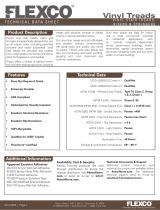 FLEXCO 42VTR00P001 Installation guide
FLEXCO 42VTR00P001 Installation guide
-
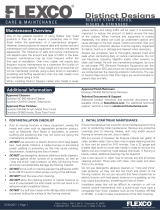 FLEXCO G4857501P020 User manual
FLEXCO G4857501P020 User manual
-
FLEXCO SP-ID1OA43 Installation guide
-
FLEXCO 40CW1P094 User manual
-
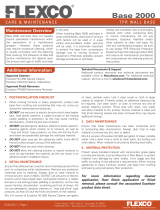 FLEXCO CF45CB3P099 User manual
FLEXCO CF45CB3P099 User manual
-
 FLEXCO VC60C01P022 User manual
FLEXCO VC60C01P022 User manual
-
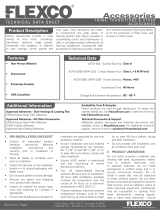 FLEXCO F141VXPALM Installation guide
FLEXCO F141VXPALM Installation guide
-
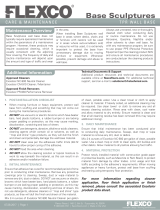 FLEXCO C45NS1P001 User manual
FLEXCO C45NS1P001 User manual
-
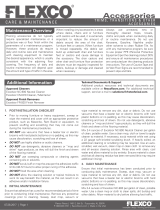 FLEXCO F141VXPALM User manual
FLEXCO F141VXPALM User manual
-
FLEXCO SP-ID1OA43 User manual
Other documents
-
 Command 03BFR Installation guide
Command 03BFR Installation guide
-
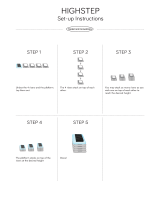 Trademark Innovations HIGHSTEP-1 User guide
Trademark Innovations HIGHSTEP-1 User guide
-
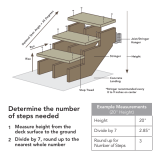 WeatherShield 163091 Installation guide
WeatherShield 163091 Installation guide
-
Simplicity by Strasser 01.193 Installation guide
-
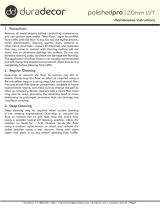 DuraDecor DD-PP-2GD8519 User guide
DuraDecor DD-PP-2GD8519 User guide
-
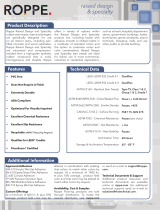 ROPPE 48961P100 Installation guide
ROPPE 48961P100 Installation guide
-
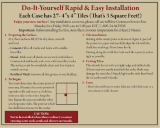 Nexus Wall Tiles WTV101NX10 Operating instructions
Nexus Wall Tiles WTV101NX10 Operating instructions
-
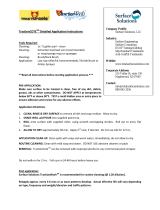 TractionCote TCTKIT Installation guide
TractionCote TCTKIT Installation guide
-
Smart Tiles SM1068-1 Installation guide
-
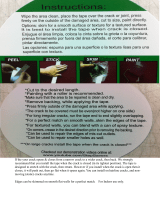 Stepsaver PRODUCTS 07050 Operating instructions
Stepsaver PRODUCTS 07050 Operating instructions
























